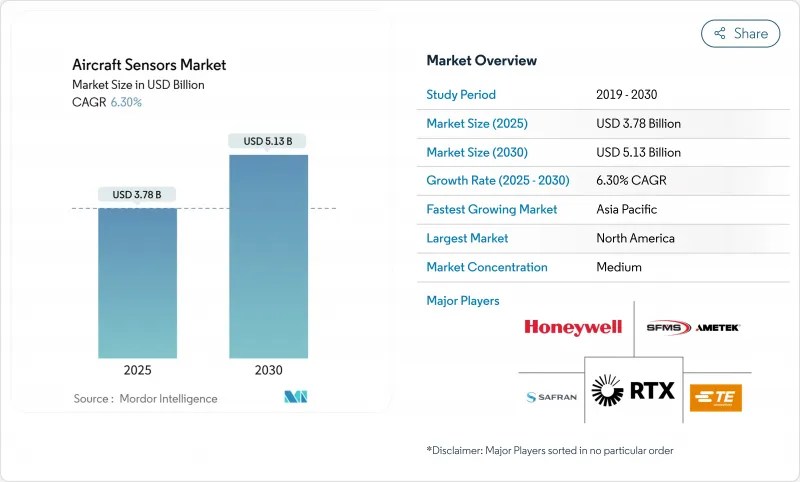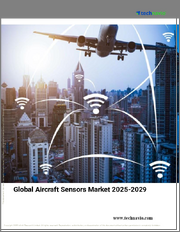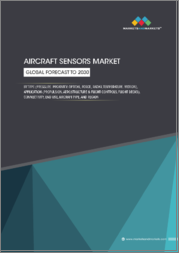
|
시장보고서
상품코드
1836677
항공기 센서 시장 : 시장 점유율 분석, 산업 동향, 통계, 성장 예측(2025-2030년)Aircraft Sensors - Market Share Analysis, Industry Trends & Statistics, Growth Forecasts (2025 - 2030) |
||||||
항공기 센서 시장 규모는 2025년에 37억 8,000만 달러로 추정되고, 2030년에는 51억 3,000만 달러에 이를 전망이며, CAGR 6.30%로 성장할 것으로 예측됩니다.

이 궤도는 항공기의 지속적인 확대, 플라이 바이 와이어 제어 시스템으로의 전환, 예지 보전 서비스의 채용 증가를 반영합니다. 미국 연방 항공국(FAA)이 2024년 항공 충돌 회피 규칙을 강화했기 때문에 운항사는 센싱 스위트 업그레이드를 강요받았고, 엔진 제조업체는 지속 가능한 항공 연료(SAF)의 연소를 지원하는 고온 센서를 도입했습니다. 항공사는 기후로 인한 난기류의 위험을 줄이려고 노력했고, 레이더 기반 기상 및 위험 회피 제품은 기세를 늘렸습니다. 군수 구매자는 근대화를 가속화하고 F-22 랩터의 적외선 업그레이드에 2억 7,000만 달러의 자금을 제공해, 고밀도로 견고한 센서 네트워크에 의존하는 자율형 플랫폼의 수주를 확대했습니다. 센서 하드웨어와 클라우드 애널리틱스를 결합한 공급업체는 프리미엄 계약을 획득했지만, 항공우주 등급 반도체의 세계 부족은 리드 타임을 늘리고 적격성 확인의 장애물을 높였습니다.
세계의 항공기 센서 시장 동향 및 인사이트
플라이 바이 와이어 및 건강 모니터링 아키텍처 채택 가속화
항공기 프로그램은 기계적 링크에서 모든 중요한 매개 변수에 대해 3중 중복 센서에 의존하는 전자 비행 제어 시스템으로 이동했습니다. 콜린스 에어로스페이스는 F-35에 탑재된 강화 전원 및 냉각 시스템을 시연하여 에너지 집약형 센서 부하를 지원하기 위해 열용량을 두배로 늘렸습니다. 항공사는 실시간 센서 스트림의 예측 분석과 결합하여 다운타임을 30% 줄이는 구조 안전성 모니터링 제품군을 통합했습니다. 센서 퓨전 소프트웨어는 압력, 관성 및 레이더 피드를 통합된 비행 이미지에 연결하여 자동 조종 응답성을 향상시키고 단일 파일럿에서 작동할 수 있도록 했습니다.
SAF 대응 엔진으로의 시프트가 고정밀 열 검출 촉진
SAF 블렌드는 연소기의 온도 프로파일을 변경하기 때문에 엔진 제조업체는 기존 트랜스듀서 한계의 3배에 가까운 1,400°F의 환경에 견딜 수 있는 열전쌍을 지정하도록 요청받고 있습니다. 미국 에너지부의 SAF 그랜드 챌린지는 2030년까지 연간 생산량 30억 갤런을 목표로 내걸고 있으며 공급망 전체에서 연료 품질 및 배출 가스 센서 수요를 자극하고 있습니다. 항공사는 세액 공제에 필요한 이산화탄소 감축의 주장을 검증하기 위해 SAF를 탑재한 디지털 연료 유량계 및 배기 가스 센서를 도입하고 있습니다.
항공우주 등급 ASIC의 지속적인 공급망 크런치
내방사선 프로세서와 혼합 신호 ASIC의 리드타임은 40주로 연장되었고, 팬데믹 전의 표준 12주를 초과했습니다. 항공 산업은 세계 칩 수요의 2% 미만이며 파운드리의 우선순위는 낮습니다. 컨설턴트는 항공우주 Tier-1의 66%가 2025년 할당 부족으로 고통받고 있다고 보고했습니다. 항공기 제조업체는 안전하고 중요한 장치를 재고하지만 재고 버퍼는 운전 자본의 필요성을 높이고 복고풍 일정을 늦추고 있습니다.
보고서에서 분석된 기타 촉진요인 및 억제요인
- 항공 충돌 회피 성능의 업그레이드에 관한 FAA의 의무화
- 커넥티드 플릿용 Drivers-as-a-Service 플랫폼의 주류화
- 인증 혼잡이 새로운 센서의 설계 도입 지연 초래
부문 분석
고정익 프로그램이 수요를 지배하고 상용 제트기 납품을 배경으로 2024년 항공기 센서 시장 점유율의 72.54%를 획득했습니다. 고정익 항공기 센서 시장 규모는 CAGR 5.8%로, 2030년까지 30억 달러 이상에 달할 것으로 예측되고 있습니다. 그 중 군용 항공기 센서는 방위성이 레거시 전투기에 광역 적외선, 레이더, 전자전 스위트를 개수함에 따라 연률 8.30%로 진보하고 있습니다. 록히드 마틴의 F-22 업그레이드는 360도 패시브 모니터링에 지불되는 프리미엄을 보여줍니다.
로터 크래프트 및 틸트 로터의 함대는 저공항 비행 중 장애물 회피를 위해 다중 스펙트럼 카메라와 라이더를 채택했습니다. 콜린스 에어로스페이스의 퍼셉션 센싱 시스템은 시야가 악화된 상황에서 자동 착륙을 가능하게 했습니다. 회전익기와 전투기간에 소프트웨어 정의 센서 프로세서를 상호 이용함으로써 비경상적인 엔지니어링 비용을 절감하고 수출 모델 시장 투입까지의 시간을 단축했습니다. 자율 화물 무인 항공기의 규모가 확대됨에 따라 경량 관성 모듈과 기압 모듈에 대한 수요는 모든 항공기 클래스에 걸쳐 항공기 센서 시장의 확대를 강화합니다.
압력 장치는 피토 정전, 환경 제어, 엔진 오일 시스템의 근간을 이루는 것으로, 안정된 대량 출하를 유지하고 있습니다. 그럼에도 불구하고 항공사는 첨단 난기류 예측 및 제빙 권고 기능을 요구하고 있기 때문에 레이더 유닛은 CAGR 9.75%로 가장 급성장을 기록했습니다. 레이더의 항공기 센서 시장 규모는 레트로핏 프로그램과 라인핏 프로그램을 모두 반영하여 2030년까지 12억 달러에 달할 것으로 예측됩니다. ACAS Xa 요구사항은 지역 제트용 공중 모니터링 레이더를 더욱 밀어 올렸습니다.
Edge-AI 패키지는 레이더, 라이더 및 광학 입력을 단일 보드에 통합하여 배선을 20% 줄이고 조건 기반 안테나 교정을 가능하게 합니다. MEMS 가속도계와 근접 검출기는 자동차 비용 곡선의 혜택을 받으면서도 RTCA DO-160의 진동 프로파일을 충족하기 위해 보완적인 스크리닝을 계속했습니다. 온도 센서 및 유량 센서 설계자는 사이버 보안 래퍼를 추가하여 부품 비용을 늘리면서 임시 FAA 네트워크 보안 의무를 충족하기 위해 장기적인 서비스 수익 전망을 강화했습니다.
지역별 분석
북미는 2024년 세계 수요의 42.52%를 차지했으며 대기업의 국방부에 대한 지출 증가와 기체 근대화 캠페인의 혜택을 받았습니다. 국내 센서 공급업체는 FAA와의 초기 단계에서의 관계를 활용하여 규격을 책정하고, 해외에서 규칙이 채택된 후에는 수출 전망을 높였습니다. 그러나 해외 칩 제조에 의존하기 때문에 워싱턴은 CHIPS 법에 따라 520억 달러를 할당하여 국내 마이크로 일렉트로닉스 능력을 강화했습니다.
항공사가 내로우 바디 기계를 확대하고 정부가 수출 규제 위험을 줄이기 위해 토착 센서 프로그램에 자금을 제공했기 때문에 아시아태평양은 CAGR 7.85%로 가장 높은 성장률을 기록했습니다. 중국의 항공 서비스 금액은 2043년까지 610억 달러에 이를 것으로 예측되어 모든 국가 시장을 능가했습니다. 일본과 한국의 제조업체가 도시형 공력 기동차용 MEMS 관성 모듈에서 협력해 인도는 지역 제트 프로젝트를 지원하기 위한 국산 항공 데이터 센서의 로드맵을 추진했습니다.
유럽은 센서의 기술 혁신을 촉진하는 엄격한 지속가능성과 사이버 보안 규칙을 시행하고 기술의 깃발 역할을 계속했습니다. 탈레스는 콥햄 에어로스페이스 커뮤니케이션즈 인수를 완료하고 센서와 안전한 데이터 링크를 융합한 아비오닉스 포트폴리오를 강화했습니다. EASA가 FAA와 일관되게 함으로써 승인의 상호 수용이 용이해졌지만, 공급업체는 여전히 별도의 문서화 흐름을 타고 있었습니다. 이 지역은 Fit-for-55 기후 패키지의 일환으로 SAF 검증 장비와 비CO2 배출량 모니터링에 중점을 두었습니다.
기타 혜택 :
- 엑셀 형식 시장 예측(ME) 시트
- 3개월간의 애널리스트 서포트
목차
제1장 서론
- 조사의 전제조건 및 시장 정의
- 조사 범위
제2장 조사 방법
제3장 주요 요약
제4장 시장 상황
- 시장 개요
- 시장 성장 촉진요인
- 플라이바이 와이어 및 헬스 모니터링 아키텍처의 채용 가속
- SAF 대응 엔진으로의 시프트에 의한 고정밀도 서멀 센싱의 추진
- FAA에 의한 항공기 충돌 회피 성능의 업그레이드 의무화
- 커넥티드 플릿용 서비스로서의 드라이버 플랫폼 주류화
- 적층 조형에 의한 센서 하우징의 단가 저감
- 엣지 AI 대응 셀프 캘리브레이션 센서에 의한 MRO 비용 절감
- 시장 성장 억제요인
- 항공우주 등급 ASIC의 지속적인 공급망 압박
- 새로운 센서의 설계를 지연시키는 인증의 백로그
- 사이버 하드닝 요건에 따른 부품 비용 상승
- MEMS IMU 수출 규제 강화
- 밸류체인 분석
- 규제 상황
- 기술적 전망
- Porter's Five Forces 분석
- 신규 참가업체의 위협
- 구매자 및 소비자의 협상력
- 공급기업의 협상력
- 대체품의 위협
- 경쟁 기업간 경쟁 관계의 강도
제5장 시장 규모 및 성장 예측 : 금액
- 항공기 유형별
- 고정익기
- 상용 항공기
- 협폭동체 항공기
- 와이드 바디 기계
- 지역 제트기
- 비즈니스 및 일반 여객기
- 비즈니스 제트
- 경량 비행기
- 군용기
- 전투기
- 수송기
- 특수 임무기
- 회전익기
- 상용 헬리콥터
- 군용 헬리콥터
- 고정익기
- 센서 유형별
- 압력
- 온도
- 위치
- 흐름
- 토크
- 레이더
- 가속도계
- 근접 센서
- 기타 센서
- 용도별
- 연료, 유압 및 공압 시스템
- 엔진 및 보조 동력 장치(APU)
- 캐빈 및 화물 환경 제어
- 비행 제어 시스템
- 비행 데크
- 착륙 장치 시스템
- 무기 시스템
- 기타
- 최종 사용자별
- OEM
- 애프터마켓 및 MRO
- 지역별
- 북미
- 미국
- 캐나다
- 멕시코
- 남미
- 브라질
- 멕시코
- 기타 남미
- 유럽
- 영국
- 프랑스
- 독일
- 이탈리아
- 스페인
- 러시아
- 기타 유럽
- 아시아태평양
- 중국
- 일본
- 인도
- 한국
- 호주
- 기타 아시아태평양
- 중동 및 아프리카
- 중동
- 사우디아라비아
- 이스라엘
- 아랍에미리트(UAE)
- 기타 중동
- 아프리카
- 남아프리카
- 기타 아프리카
- 북미
제6장 경쟁 구도
- 시장 집중도
- 전략적 동향
- 시장 점유율 분석
- 기업 프로파일
- TE Connectivity Corporation
- Honeywell International Inc.
- Meggitt PLC
- AMETEK Aerospace, Inc.
- Thales Group
- Collins Aerospace(RTX Corporation)
- Curtiss-Wright Corporation
- Safran SA
- Hydra-Electric Company
- PCB Piezotronics, Inc.(Amphenol Corporation)
- Precision Sensors(United Electric Controls)
- Moog Inc.
- Garmin Ltd.
- TT Electronics plc
- Woodward, Inc.
- EMCORE Corporation
- Bosch General Aviation Technology GmbH(Robert Bosch GmbH)
- Eaton Corporation plc
- Crane Company
제7장 시장 기회 및 전망
AJY 25.10.27The aircraft sensors market size stood at USD 3.78 billion in 2025 and is forecasted to climb to USD 5.13 billion by 2030, advancing at a 6.30% CAGR.

This trajectory reflects sustained fleet expansion, the migration to fly-by-wire control systems, and rising adoption of predictive maintenance services. Operators are compelled to upgrade sensing suites after the Federal Aviation Administration (FAA) tightened airborne collision-avoidance rules in 2024, while engine makers introduced higher-temperature sensors that support sustainable aviation fuel (SAF) combustion. Radar-based weather and hazard-avoidance products gained momentum as carriers sought to mitigate climate-driven turbulence risk. Military buyers accelerated modernization, funding a USD 270 million infrared upgrade for the F-22 Raptor and expanding orders for autonomous platforms that depend on dense, rugged sensor networks. Suppliers that combined sensor hardware with cloud analytics captured premium contracts, yet global shortages of aerospace-grade semiconductors stretched lead times and intensified qualification hurdles.
Global Aircraft Sensors Market Trends and Insights
Accelerated Adoption of Fly-by-Wire and Health-Monitoring Architectures
Aircraft programs shifted from mechanical linkages to electronic flight-control systems that rely on triple-redundant sensors for every critical parameter. Collins Aerospace demonstrated its Enhanced Power and Cooling System on the F-35, doubling thermal capacity to support energy-intensive sensor loads. Airlines integrated structural-health-monitoring suites that cut downtime by 30% when combined with predictive analytics from real-time sensor streams. Sensor fusion software stitched pressure, inertial, and radar feeds into a unified flight picture, improving autopilot responsiveness and enabling single-pilot operations.
Shift to SAF-Ready Engines Driving High-Accuracy Thermal Sensing
SAF blends alter combustor temperature profiles, prompting engine makers to specify thermocouples capable of surviving 1,400°F environments-nearly triple the limit of erstwhile transducers. The US Department of Energy's SAF Grand Challenge targeted 3 billion gallons of annual output by 2030, stimulating demand for fuel-quality and emissions sensors across supply chains. Airlines are deploying SAF-equipped digital fuel-flow meters and exhaust-gas sensors to verify carbon-reduction claims required for tax credits.
Persistent Supply-Chain Crunch of Aerospace-Grade ASICs
Lead times for radiation-tolerant processors and mixed-signal ASICs lengthened to 40 weeks, overshadowing pre-pandemic norms of 12 weeks. Aviation represented less than 2% of global chip demand, leaving it low on foundry priority lists. Consultancies reported that 66% of aerospace Tier-1s struggled with allocation shortfalls in 2025. Airframers stocked safety-critical devices, yet inventory buffers raised working-capital needs and delayed retrofit schedules.
Other drivers and restraints analyzed in the detailed report include:
- FAA Mandate on Airborne Collision-Avoidance Upgrades
- Mainstream Drivers-as-a-Service Platforms for Connected Fleets
- Certification Backlog Slowing New Sensor Design-ins
For complete list of drivers and restraints, kindly check the Table Of Contents.
Segment Analysis
Fixed-wing programs dominated demand, capturing 72.54% of the aircraft sensors market share in 2024 on the strength of commercial jet deliveries. The aircraft sensors market size for fixed-wing applications is projected to exceed USD 3 billion by 2030 at a 5.8% CAGR. Within that total, military aviation sensors are advancing 8.30% annually as defense ministries retrofit legacy fighters with wide-area infrared, radar, and electronic-warfare suites. Lockheed Martin's F-22 upgrade illustrated the premium paid for 360-degree passive surveillance.
Rotorcraft and tilt-rotor fleets embraced multispectral cameras and lidar for obstacle avoidance during low-altitude operations. Collins Aerospace's perception-sensing system enabled automated landing in degraded visual conditions. Cross-pollination of software-defined sensor processors between rotorcraft and fighter jets cut non-recurring engineering costs, compressing time-to-market for export variants. As autonomous cargo drones scale, demand for lightweight inertial and barometric modules will reinforce the expansion of the aircraft sensors market across all airframe classes.
Pressure devices remained foundational underlying pitot-static, environmental-control, and engine-oil systems with stable, high-volume shipments. Still, radar units registered the steepest growth at 9.75% CAGR as airlines sought advanced turbulence prediction and de-icing advisory features. The aircraft sensors market size for radar is forecast to reach USD 1.2 billion by 2030, reflecting both retrofit and line-fit programs. ACAS Xa requirements further boosted airborne surveillance radars for regional jets.
Edge-AI packages integrated radar, lidar, and optical inputs on a single board, reducing wiring by 20% and enabling condition-based antenna calibration. MEMS accelerometers and proximity detectors benefited from automotive cost curves yet continued to undergo supplemental screening to meet RTCA DO-160 vibration profiles. Temperature and flow sensor designers added cybersecurity wrappers to satisfy imminent FAA network-security mandates, raising bill-of-materials cost but cementing long-term service revenue prospects.
The Aircraft Sensors Market Report is Segmented by Aircraft Type (Fixed-Wing and Rotary-Wing), Sensor Type (Temperature, Pressure, Position, Flow, Torque, Radar, and More), Application (Fuel, Hydraulic and Pneumatic Systems, Engine and Auxiliary Power Unit (APU), and More), End User (OEM and Aftermarket/MRO), and Geography (North America, Europe, Asia-Pacific, and More). The Market Forecasts are Provided in Terms of Value (USD).
Geography Analysis
North America retained 42.52% of global demand in 2024, benefiting from major airlines' elevated Pentagon outlays and fleet-modernization campaigns. Domestic sensor suppliers leveraged early engagement with the FAA to shape standards, enhancing export prospects once rules were adopted abroad. Yet the reliance on offshore chip fabrication prompted Washington to allocate USD 52 billion under the CHIPS Act to bolster local microelectronics capacity.
Asia-Pacific recorded the highest growth rate at 7.85% CAGR as carriers expanded narrowbody fleets and governments funded Indigenous sensor programs to mitigate export-control risks. China's aviation services value was forecast to hit USD 61 billion by 2043, eclipsing every single country market. Japanese and Korean manufacturers collaborated on MEMS inertial modules for urban-air-mobility vehicles, while India advanced roadmaps for domestically produced air-data sensors to support regional jet projects.
Europe remained a technology bellwether, enforcing stringent sustainability and cybersecurity rules that fostered sensor innovation. Thales completed the Cobham Aerospace Communications acquisition, reinforcing avionics portfolios that blend sensors and secure datalinks. EASA's harmonization with the FAA facilitated reciprocal acceptance of approvals, but suppliers still navigated separate documentation streams. The region emphasized SAF validation instrumentation and non-CO2 emissions monitoring as part of its Fit-for-55 climate package.
- TE Connectivity Corporation
- Honeywell International Inc.
- Meggitt PLC
- AMETEK Aerospace, Inc.
- Thales Group
- Collins Aerospace (RTX Corporation)
- Curtiss-Wright Corporation
- Safran SA
- Hydra-Electric Company
- PCB Piezotronics, Inc. (Amphenol Corporation)
- Precision Sensors (United Electric Controls)
- Moog Inc.
- Garmin Ltd.
- TT Electronics plc
- Woodward, Inc.
- EMCORE Corporation
- Bosch General Aviation Technology GmbH (Robert Bosch GmbH)
- Eaton Corporation plc
- Crane Company
Additional Benefits:
- The market estimate (ME) sheet in Excel format
- 3 months of analyst support
TABLE OF CONTENTS
1 INTRODUCTION
- 1.1 Study Assumptions and Market Definition
- 1.2 Scope of the Study
2 RESEARCH METHODOLOGY
3 EXECUTIVE SUMMARY
4 MARKET LANDSCAPE
- 4.1 Market Overview
- 4.2 Market Drivers
- 4.2.1 Accelerated adoption of fly-by-wire and health-monitoring architectures
- 4.2.2 Shift to SAF-ready engines driving high-accuracy thermal sensing
- 4.2.3 FAA mandate on airborne collision-avoidance upgrades
- 4.2.4 Mainstream drivers-as-a-service platforms for connected fleets
- 4.2.5 Additive-manufactured sensor housings reducing unit cost
- 4.2.6 Edge-AI-enabled self-calibrating sensors lowering MRO spend
- 4.3 Market Restraints
- 4.3.1 Persistent supply-chain crunch of aerospace-grade ASICs
- 4.3.2 Certification backlog slowing new sensor design-ins
- 4.3.3 Cyber-hardening requirements inflating BOM cost
- 4.3.4 Export-control tightening on MEMS IMUs
- 4.4 Value Chain Analysis
- 4.5 Regulatory Landscape
- 4.6 Technological Outlook
- 4.7 Porter's Five Forces Analysis
- 4.7.1 Threat of New Entrants
- 4.7.2 Bargaining Power of Buyers/Consumers
- 4.7.3 Bargaining Power of Suppliers
- 4.7.4 Threat of Substitute Products
- 4.7.5 Intensity of Competitive Rivalry
5 MARKET SIZE AND GROWTH FORECASTS (VALUE)
- 5.1 By Aircraft Type
- 5.1.1 Fixed-Wing
- 5.1.1.1 Commercial Aviation
- 5.1.1.1.1 Narrowbody Aircraft
- 5.1.1.1.2 Widebody Aircraft
- 5.1.1.1.3 Regional TJets
- 5.1.1.2 Business and General Aviation
- 5.1.1.2.1 Business Jets
- 5.1.1.2.2 Light Aircraft
- 5.1.1.3 Military Aviation
- 5.1.1.3.1 Fighter Aircraft
- 5.1.1.3.2 Transport Aircraft
- 5.1.1.3.3 Special Mission Aircraft
- 5.1.2 Rotary-Wing
- 5.1.2.1 Commercial Helicopters
- 5.1.2.2 Military Helicopters
- 5.1.1 Fixed-Wing
- 5.2 By Sensor Type
- 5.2.1 Pressure
- 5.2.2 Temperature
- 5.2.3 Position
- 5.2.4 Flow
- 5.2.5 Torque
- 5.2.6 Radar
- 5.2.7 Accelerometers
- 5.2.8 Proximity
- 5.2.9 Other Sensors
- 5.3 By Application
- 5.3.1 Fuel,Hydraulic and Pneumatic Systems
- 5.3.2 Engine and Auxiliary Power Unit (APU)
- 5.3.3 Cabin and Cargo Environmental Controls
- 5.3.4 Flight Control Systems
- 5.3.5 Flight Decks
- 5.3.6 Landing Gear Systems
- 5.3.7 Weapon Systems
- 5.3.8 Others
- 5.4 By End User
- 5.4.1 OEM
- 5.4.2 Aftermarket/MRO
- 5.5 Geography
- 5.5.1 North America
- 5.5.1.1 United States
- 5.5.1.2 Canada
- 5.5.1.3 Mexico
- 5.5.2 South America
- 5.5.2.1 Brazil
- 5.5.2.2 Mexico
- 5.5.2.3 Rest of South America
- 5.5.3 Europe
- 5.5.3.1 United Kingdom
- 5.5.3.2 France
- 5.5.3.3 Germany
- 5.5.3.4 Italy
- 5.5.3.5 Spain
- 5.5.3.6 Russia
- 5.5.3.7 Rest of Europe
- 5.5.4 Asia-Pacific
- 5.5.4.1 China
- 5.5.4.2 Japan
- 5.5.4.3 India
- 5.5.4.4 South Korea
- 5.5.4.5 Australia
- 5.5.4.6 Rest of Asia-Pacific
- 5.5.5 Middle East and Africa
- 5.5.5.1 Middle East
- 5.5.5.1.1 Saudi Arbaia
- 5.5.5.1.2 Israel
- 5.5.5.1.3 United Arab Emirates
- 5.5.5.1.4 Rest of Middle East
- 5.5.5.2 Africa
- 5.5.5.2.1 South Africa
- 5.5.5.2.2 Rest of Africa
- 5.5.1 North America
6 COMPETITIVE LANDSCAPE
- 6.1 Market Concentration
- 6.2 Strategic Moves
- 6.3 Market Share Analysis
- 6.4 Company Profiles (includes Global level Overview, Market level overview, Core Segments, Financials as available, Strategic Information, Market Rank/Share for key companies, Products and Services, and Recent Developments)
- 6.4.1 TE Connectivity Corporation
- 6.4.2 Honeywell International Inc.
- 6.4.3 Meggitt PLC
- 6.4.4 AMETEK Aerospace, Inc.
- 6.4.5 Thales Group
- 6.4.6 Collins Aerospace (RTX Corporation)
- 6.4.7 Curtiss-Wright Corporation
- 6.4.8 Safran SA
- 6.4.9 Hydra-Electric Company
- 6.4.10 PCB Piezotronics, Inc. (Amphenol Corporation)
- 6.4.11 Precision Sensors (United Electric Controls)
- 6.4.12 Moog Inc.
- 6.4.13 Garmin Ltd.
- 6.4.14 TT Electronics plc
- 6.4.15 Woodward, Inc.
- 6.4.16 EMCORE Corporation
- 6.4.17 Bosch General Aviation Technology GmbH (Robert Bosch GmbH)
- 6.4.18 Eaton Corporation plc
- 6.4.19 Crane Company
7 MARKET OPPORTUNITIES AND FUTURE OUTLOOK
- 7.1 White-space and Unmet-Need Assessment

















